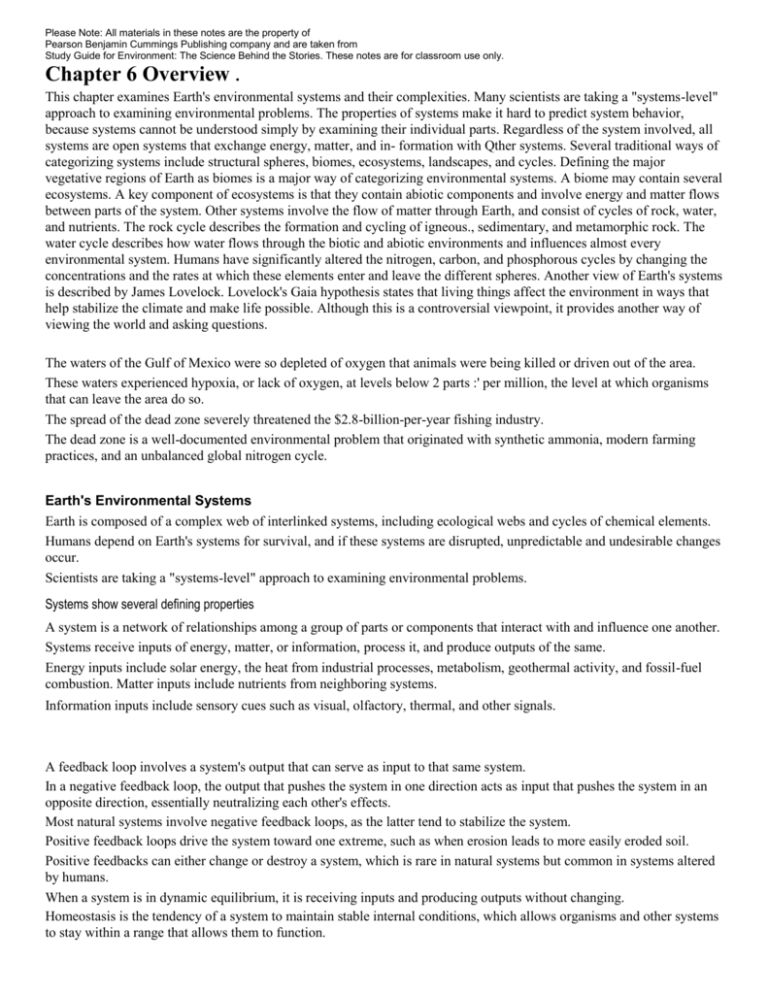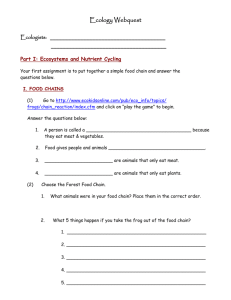Chapt6 - Institute of Applied Science
advertisement

Please Note: All materials in these notes are the property of Pearson Benjamin Cummings Publishing company and are taken from Study Guide for Environment: The Science Behind the Stories. These notes are for classroom use only. Chapter 6 Overview . This chapter examines Earth's environmental systems and their complexities. Many scientists are taking a "systems-level" approach to examining environmental problems. The properties of systems make it hard to predict system behavior, because systems cannot be understood simply by examining their individual parts. Regardless of the system involved, all systems are open systems that exchange energy, matter, and in- formation with Qther systems. Several traditional ways of categorizing systems include structural spheres, biomes, ecosystems, landscapes, and cycles. Defining the major vegetative regions of Earth as biomes is a major way of categorizing environmental systems. A biome may contain several ecosystems. A key component of ecosystems is that they contain abiotic components and involve energy and matter flows between parts of the system. Other systems involve the flow of matter through Earth, and consist of cycles of rock, water, and nutrients. The rock cycle describes the formation and cycling of igneous., sedimentary, and metamorphic rock. The water cycle describes how water flows through the biotic and abiotic environments and influences almost every environmental system. Humans have significantly altered the nitrogen, carbon, and phosphorous cycles by changing the concentrations and the rates at which these elements enter and leave the different spheres. Another view of Earth's systems is described by James Lovelock. Lovelock's Gaia hypothesis states that living things affect the environment in ways that help stabilize the climate and make life possible. Although this is a controversial viewpoint, it provides another way of viewing the world and asking questions. The waters of the Gulf of Mexico were so depleted of oxygen that animals were being killed or driven out of the area. These waters experienced hypoxia, or lack of oxygen, at levels below 2 parts :' per million, the level at which organisms that can leave the area do so. The spread of the dead zone severely threatened the $2.8-billion-per-year fishing industry. The dead zone is a well-documented environmental problem that originated with synthetic ammonia, modern farming practices, and an unbalanced global nitrogen cycle. Earth's Environmental Systems Earth is composed of a complex web of interlinked systems, including ecological webs and cycles of chemical elements. Humans depend on Earth's systems for survival, and if these systems are disrupted, unpredictable and undesirable changes occur. Scientists are taking a "systems-level" approach to examining environmental problems. Systems show several defining properties A system is a network of relationships among a group of parts or components that interact with and influence one another. Systems receive inputs of energy, matter, or information, process it, and produce outputs of the same. Energy inputs include solar energy, the heat from industrial processes, metabolism, geothermal activity, and fossil-fuel combustion. Matter inputs include nutrients from neighboring systems. Information inputs include sensory cues such as visual, olfactory, thermal, and other signals. A feedback loop involves a system's output that can serve as input to that same system. In a negative feedback loop, the output that pushes the system in one direction acts as input that pushes the system in an opposite direction, essentially neutralizing each other's effects. Most natural systems involve negative feedback loops, as the latter tend to stabilize the system. Positive feedback loops drive the system toward one extreme, such as when erosion leads to more easily eroded soil. Positive feedbacks can either change or destroy a system, which is rare in natural systems but common in systems altered by humans. When a system is in dynamic equilibrium, it is receiving inputs and producing outputs without changing. Homeostasis is the tendency of a system to maintain stable internal conditions, which allows organisms and other systems to stay within a range that allows them to function. Systems can also show emergent properties, which are characteristics that are not evident in the separate parts of the system but only become evident when the system is whole. Systems do not usually have well-defined boundaries that tell where the system begins and ends. A closed system is one that is isolated and self-contained. In reality, all systems ~re open systems that exchange energy, matter, and information with other systems. The Mississippi River is an environmental system The Mississippi River is an example of a natural system, because it receives input, produces output, and shows emergent properties. The hundreds of rivers and tributaries of the Mississippi River system flow through vast expanses of landscape, carrying nutrients, soils, and pollutants. Defining its boundaries is complicated because those boundaries depend on the environmental questions being asked. Understanding the hypoxia problem requires considering the Mississippi River and the Gulf of Mexico together as a system The cause of the hypoxia in the Gulf of Mexico is excess nitrogen, mostly from fertilizers applied to crops, leaky septic fields, and runoff from city streets. Excess nitrogen promotes the growth of phytoplankton, microscopic organisms that use the nitrogen to grow. Increased populations of phytoplankton produce more waste, which, along with dead phytoplankton, increases populations of decomposers that use up oxygen in the water, suffocating fish and shrimp, causing the dead zone. Eutrophication is the process of nutrient enrichment, increased production of organic matter, and ecosystem degradation of water bodies. Environmental systems may be perceived in different ways Traditional methods of categorizing environmental systems include structural spheres, biomes, ecosystems, landscapes, and cycles. Breaking down complex systems enables us to understand the system and solve problems associated with it. Earth can be divided into several structural spheres: atmosphere, hydrosphere, lithosphere, and biosphere Earth can be divided into several major structural categories. The lithosphere is the solid earth, including rocks, sediments, and soil. The hydrosphere is all the water, including oceans, rivers, lakes, ice, and vapor, both on Earth's surface and in the atmosphere. The atmosphere is the air surrounding the planet. The biosphere is all the living organisms and the abiotic parts of the environment that the organisms interact with. Biomes are fundamental groupings of plant communities that cover large geographic areas A biome is a major regional complex of similar plant communities defined by a dominant plant type. Climate plays a major role in defining the biome present in an area. A climate diagram, or climatograph, provides information on an area's temperature and precipitation, and the resulting biome that exists. The same biomes tend to occur along similar latitudes, so that different continents can have similar biomes. A biome can have several different ecosystems (a community along with the local abiotic factors) within its borders. We can divide the world into roughly ten biomes Temperate deciduous forest is characterized by broad-leafed trees that lose their leaves in the fall. Precipitation is spread evenly throughout the year, and the soils are relatively fertile. These forests occur in Europe, eastern China, and eastern North America. This biome has fewer tree species than other forest biomes. Temperate grassland has increased temperature differences between winter and summer, and less rainfall; it more easily supports grasses than trees. Grasslands are located in North and South America and central Asia. Most grasslands have been converted to cropland and rangeland, reducing the number of grazers and predators that used to live on the grasslands. Temperate rainforest has heavy rainfall, which produces forests with high biodiversity and rich soils. This makes it commercially valuable, but susceptible to erosion and landslides after deforestation. The Pacific North- west has this type of biome. Tropical rainforest is characterized by a year-round rainy season and uniformly warm temperatures. This biome has great biodiversity but very poor, acidic soils. It is found in Central and South America and other tropical regions. Tropical dry forest occurs in tropical areas that are warm year round but have lower rainfall, such as in India, Africa, South America, and northern Australia. This biome has equal wet and dry seasons, with severe problems of soil erosion during the rainy season. Savannas are regions of grasslands interspersed with trees, and are found across Africa, South America, Australia, and India. This biome has distinct rainy seasons, and has vast herds of grazing herbivores (zebras and gazelles) and predators (lions and hyenas). Desert has very sparse rainfall, and is the driest biome on Earth because rain may not fall for years. Deserts vary greatly in their vegetation, and are not always hot. Deserts have extreme temperature variations because of the lack of vegetation, and can be cold during the night. High winds and heavy rainfall can lead to flooding, and soils have little organic matter. Plants and animals have evolved adaptations to deal with this harsh climate and lack of water. Tundra is as dry as desert, but is located at very high latitudes in Russia, Canada, Scandinavia, and Alaska. This biome has long, extremely cold winters and moderately cool summers. Vegetation is low and scrubby, and mosquitoes breed readily during the summer. Taiga is the northern coniferous forest that stretches across Canada, Alaska, Russia, and Scandinavia. Long, cold winters and short, cool summers pro- duce drier regions with nutrient-poor, acidic soils. Most animals such as lynx, moose, wolves, and bear breed during the short, wet summer months. Chaparral is limited to several small areas and consists of shrubs. It has mild, wet winters and warm, dry summers. It is also called "Mediterranean," and is located in southern Europe, California, Chile, and southern Australia. These communities have frequent fires and their plant species are adapted to resist fire. Altitude creates patterns analogous to latitude Vegetative communities and animals change in response to increasing altitude. Communities are often isolated in high altitudes, which can make isolated species vulnerable to extinction. Aquatic systems also show biome-like patterns of variation and similarity The biome concept is traditionally applied to terrestrial systems, but aquatic systems can also be considered biomes. Oceans, coastlines, freshwater lakes, and other coastal systems can be considered biomes. Aquatic biomes are not influenced as much by air temperature and precipitation as by salinity, water temperature, nutrients, currents, waves, and depth. Ecosystems are key environmental systems An ecosystem describes all the interacting organisms and abiotic factors occurring in a particular place at that time. Ecosystems can be huge or very small, but they usually describe interactive systems limited to a smaller geographic area with generally discrete borders. A key component of ecosystems is that they contain abiotic components and involve energy and matter flows between parts of the system. Energy from the sun is converted by producers into biomass, matter contained in living organisms. Ecosystems with high primary productivity are those that rapidly convert solar energy into biomass. Coral reefs and other marine ecosystems have the highest primary productivity. Net primary productivity is the biomass available to consumers. Wetlands and tropical rainforests have high net primary productivity, whereas marine ecosystems have low net primary productivity, because they use most of the energy for themselves, with very little available for consumers. Landscape ecology is the study of geographical areas that include multiple ecosystems Adjacent ecosystems interact with each other. Ecotones are areas where ecosystems meet and where biotic and abiotic elements in the ecosystems mix. Landscape ecologists often view systems on a large landscape scale that includes multiple ecosystems. How Environmental Systems Work The flow of matter through the Earth involves cycles of rock, water, and four key nutrients. The rock cycle is a slow, but important, environmental system The rock cycle involves rocks and minerals being heated, melted, cooled, broken, and reassembled in a very slow process. Igneous rock is formed when molten, liquid rock, called magma, cools. Intrusive igneous rock forms when magma cools slowly while it is below the Earth's surface. Granite is one example of this type of igneous rock. When magma is spewed from a volcano, it is called lava. The lava cools relatively quickly, and the resulting rock is called extrusive igneous rock. Basalt is one type of this rock. Sedimentary rock is begun when wind and water erode rocks, and the resulting sediment is deposited in various areas over many years. Sediments collect, increasing the weight on lower layers of sediment. Sedimentary rock forms when dissolved minerals seep through sediment layers and bind the sediment together. Chemical sedimentary rocks form when dissolved rocks crystallize (e..g., limestone). Clastic sedimentary rock forms when layers of sediment are compressed. Conglomerate is clastic rock that is made up of large particles. Sandstone is rock made of cemented sand particles. Shale is made of small particles of mud compacted together. Metamoryhic rock undergoes enormous heat or pressure, so much that the crystals within the rock are changed in appearance and physical properties. Types of metamorphic rock include marble (from heated limestone) and slate (from heated shale). Plate tectonics shapes the geography of Earth Plate tectonics involves movement of Earth's lithosphere. Earth's thin crust floats on top of the mantle, which surrounds a molten heavy core of iron in the center of Earth. The internal heat of Earth moves the mantle upward and downward, which causes the surface edges of large plates (tectonic plates) of crust to move. Earth has 15 tectonic plates, which move at about 1-6 inches per year. This movement has influenced Earth's climate and evolution as continents move together or apart. At one time, all landmasses were joined into one supercontinent called "Pangaea." Colliding plates form mountains, such as the Himalayas and the Appalachian Mountains. When plates collide, the heavier plate can also slide underneath the lighter plate, in a process called subduction. As the lighter crust gets pushed into Earth, it gets heated and sends up magma in a volcano, such as in the Andes mountains and the 1980 eruption of Mount St. Helens in Washington.. The hydrologic cycle influences all other cycles The water, or hydrologic, cycle describes how water flows through the biotic and abiotic environments, and influences almost every environmental system. The oceans are the major reservoir of water in the hydrologic cycle; they hold over 97% of all Earth's water. Less than 1 % of the planet's water is in a form humans can easily use (groundwater, freshwater, rain). Evaporation and transpiration: Water moves from Earth's surface to the atmosphere via evaporation, which turns liquid water into gaseous form. Deforestation and urbanization increase evaporation. Transpiration is the release of water vapor from plants during photosynthesis. Precipitation, runoff, and surface water: Precipitation occurs when water vapor condenses and falls in droplet or crystal form, such as rain and snow. Runoff is the flow of water into streams, rivers, lakes, ponds, etc. . The amount of precipitation varies greatly around the planet and influences the types of biomes present. Mountain ranges can cause water vapor to condense and fall as rain on one side of the mountain, while the other side (the rain shadow side) receives only dry air. Precipitation is involved in a negative feedback loop with evaporation and transpiration. Groundwater: Some precipitation and surface waters soak into aquifers, regions of rock and soil that hold groundwater (water found underground). The water table is the upper limit of the aquifer. Some aquifers can take thousands of years to recharge after being depleted. Human impacts on the hydrologic cycle: Humans have affected every part of the water cycle. Damming rivers increases evaporation, and changing Earth's surface in- creases runoff. Groundwater is being depleted, as are rivers and lakes. Transpiration is reduced through deforestation, and air pollution changes the chemical nature of precipitation. Water shortages have already led to war throughout the world. Groundwater, a critical resource for humans, is especially vulnerable. All over the world, groundwater extraction is exceeding recharge; eventually, an aquifer can be depleted and run out of water. There are more people using more water than ever before, resulting in worldwide groundwater depletion. Dropping water tables can cause problems for farmers, dry up wetlands, and lead to sinkholes. Biogeochemical cycles are essential to understanding .ecosystems Some environmental cycles move nutrients, elements, and compounds that organisms require for survival through the environment. During the nutrient, or biogeochemical, cycles, these substances move through the environment and support life on Earth. All organisms require macronutrients (elements and compounds required in large amounts) such as nitrogen, carbon, phosphorus, and sulfur. Organisms also require micronutrients, elements and compounds required in very small amounts. The nitrogen cycle has changed dramatically in recent decades Nitrogen, transferred through the nitrogen cycle, is the sixth most abundant element on Earth and is essential for DNA, RNA, and proteins. Despite its abundance, nitrogen cannot cycle out of the atmosphere easily, but once it does become available, it is a potent fertilizer. Because of its scarcity, nitrogen was once the limiting factor for plants, including crops, and therefore limited human population growth. Nitrogen fixing and nitrification: In order for nitrogen to be useful to plants, nitrogen gas must be converted into ammonium ions by being combined with hydrogen in a process called nitrogen fixation. Nitrogen fixation occurs through lightning strikes or nitrogen-fixing bacteria that live on top of the soil. Nitrification then occurs when other forms of bacteria change ammonium ions into nitrite ions and then into nitrate ions. Ammonium and nitrate ions are the only forms of nitrogen that plants can absorb. Consumption, decomposition, and denitrifying bacteria: Animals get their nitrogen through consumption of plants or other animals. Decomposers process dead organisms and release ammonium, which bacteria can then convert into nitrites and nitrates that continue through the cycle. Denitrifying bacteria convert nitrates in soil or water into gaseous nitrogen, completing the cycle. Human impacts on the nitrogen cycle: In the past, nitrogen fixation was a "bottleneck" that limited the amount of nitrogen available to plants. In the early 1900s, scientists discovered how to produce ammonia on an industrial scale. Nitrogen could then be used as a fertilizer for crops, which contributed to enormous growth in the human population. Humans are fixing as much nitrogen as nature does, doubling the rate of nitrogen fixation. Enormous amounts of additional nitrogen are forced into the cycle through the burning of fossil fuels, forests, and fields, the bacterial break- down of livestock wastes in feedlots, and the destruction of wetlands. The additional nitrogen available to plants acts as a fertilizer, causing algal blooms in waterways, which lead to massive fish die-offs. Other ecosystem effects include increased amounts of nitrogen gas that produce smog, depletion of calcium and potassium from soils, acidified soils and water, reduced biological diversity, and harmed coastal ecosystems. The carbon cycle moves organic nutrients through the environment Organic molecules such as carbohydrates, fats, and proteins all contain carbon. The movement of carbon through the environment is described by the carbon cycle. Photosynthesis and food webs: Food webs move carbon atoms through the carbon cycle in many ways. Through photosynthesis, plants use atmospheric carbon dioxide to pro- duce oxygen and carbohydrates Through respiration, consumption, and decomposition, organisms metabolize and release carbon dioxide back into the atmosphere. Sediment storage of carbon atoms: The largest. source of carbon is located in sedimentary rock and fossil fuels, which form when dead organisms sink to the bottoms of water bodies and undergo high pressure over long periods of time. Carbon trapped in sedimentary rock can remain there for hundreds of millions of years, and can be released through erosion or extraction and burning of fossil fuels. t: The oceans and the carbon cycle: Oceans, the second largest source of carbon, get carbon from runoff, the atmosphere, undersea volcanic eruptions, and waste products and bodies of marine organisms. Calcium carbonate, an essential ingredient in the shells and skeletons of marine organisms, forms when carbon ions combine with calcium ions. When these organisms die, their skeletons begin to form sedimentary rock. Human impacts on the carbon cycle: Humans have changed the amount of time carbon stays in various parts of the cycle and the concentrations of carbon in each of the cycle's compartments. Humans have released enormous amounts of carbon into the atmosphere through the burning of fossil fuels and forests. As a result, the atmospheric concentration of carbon dioxide is the high- est in the past 420,000 years. The phosphorous cycle plays a key role in the conversion of energy via metabolism Phosphorus is important in compounds that organisms use as energy sources and as components in DNA and RNA. Phosphorus is most abundant in rocks and is released as phosphate into water when rocks weather. Food webs and phosphorus: Plants can take up phosphate through their ii roots. Animals obtain phosphorus when they eat plants, and when they die, phosphorus is returned to the soil. Geology and phosphorus availability: Concentrations of available phosphorus in the environment are low, making it a limiting factor in plant growth. , Human impacts on the phosphorous cycle: Extra phosphates from fertilizers or sewage increase algal growth and can significantly change aquatic ecosystems. The Gaia hypothesis portrays Earth as a self-regulating system t In the 1970s, James Lovelock described Earth as a superorganism, which behaves like a single self-regulating system. Lovelock's Gaia hypothesis states that living organisms affect the environment in ways that help stabilize and influence the climate and make life possible. For example, plants produce oxygen that removes carbon dioxide from the atmosphere, allowing other life forms to exist. Other scientists discount the Gaia hypothesis, and state that the remark- able stability of Earth is an accident. The anthropic principle states that humans notice the accidental stability of Earth only because we are around to notice it.









